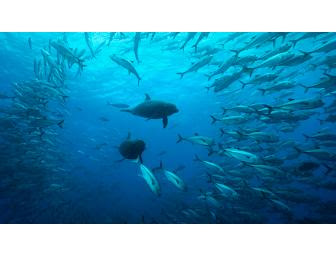I’m still reeling from my first dive at Cocos Island. Until yesterday, I had planned to take Sunday to hike to the peak of the island, Cerro Iglesias, but when Esteban, the park’s Acting Director, asked if I wanted to dive on Sunday, there was really no choice to be made. Which activity would your prefer? Diving, obviously.
Under textured gray skies, we took the park’s rubber launch out to Sea Hunter, anchored in the not-so-calm of Wafer Bay, where we picked up Jay Ireland and Georgienne Bradley (Sea Save Foundation leaders), who had arranged and were to accompany us on this dive. Our destination: Manuelita, the largest of the satellite islets surrounding the island. Our dive site was on the western side of the islet, and is the deeper of the two dive sites around Manuelita.
Amidst the six to eight foot swells and the noise of water crashing against the rock in a spray of white foam, we strapped on our weight belts, double checked the quantity of air in the tanks before donning our dive vests, flippers and masks, and then before I could think twice about it, we had flipped over the side of the boat and were plunging down, down, down. 15 m. 20 m. 25 m. At 33 m. (110 ft) below the surface, we stopped. At this depth, the steep, rocky shelf of Manuelita meets with the sandy, downward-sloping plain of the ocean-bottom that disappears into a deep blue gloom. In between the rasp of inhaled air, and the stream of bubbles that comes with the exhale, there was an incredible calm, a profound stillness. Not silence, exactly. I could still hear the faint, distorted sounds of the sea. But what a contrast to the roiling surface 110 feet overhead! The feeling of calm penetrated deep into my mind and muscles. My body relaxed, breathing came easier.
In this peaceful state on the ocean-bottom, all traces of fear and tension were gone, and my mind was open to the wonders around me. When the first hammerhead shark appeared out of the gloom, it was not fear that paralyzed me, but wonder – giddy, innocent, child-like wonder. I was amazed by its bizarre, other-worldly, and beautiful shape. I was struck dumb by the powerful, elastic undulation with which it propelled itself. And then more came. Dozens of hammerheads, hazy shapes in the gloom, then closer and clearer, then silhouettes swimming overhead. Languidly drifting along now, then darting quickly to the right to nab some small, unseen fish. I’ve never seen anything like it.
As we slowly made our way along the shelf of Manuelita, away from the hammerheads, we saw rays, trumpet fish, urchins, white tip reef sharks, and myriads of fish for which I don’t know the name. But I could spent hours documenting the dozens of species. It was indescribable. Incredible.
The problem with diving is that the return to the surface is inevitable. It was with regret, and a pang of jealousy for those species lucky enough to dwell beneath the surface of the water, that I surfaced and climbed back into the boat. As we motored through the surf back to the Wafer Bay Station, I sat in silent awe of this place, of Cocos Island, and then this David Attenborough quote from my highschool environmental science teacher popped into my head:
“It seems to me that the natural world is the greatest source of excitement; the greatest source of visual beauty; the greatest source of intellectual interest. It is the greatest source of so much in life that makes life worth living.” – David Attenborough
And then the words of a good friend came to my mind, uttered after a near lightning strike and a mad dash for cover in a thunderstorm:
“God, what a great planet”
I couldn’t agree more.





